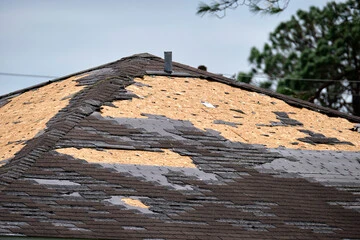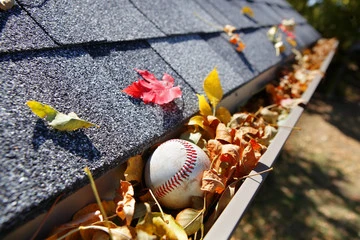
You’ve just weathered a severe windstorm, and you’re growing concerned about potential damage to your roof. It’s a fact that high winds can cause significant harm to your home’s first line of defense.
This blog post will guide you through the steps to address wind-induced damage on your roof so that you can complete the proper storm damage repairs.
Assessing Wind Damage to the Roof
Review your homeowner’s insurance policy and contact them to report the wind damage.
Review homeowners insurance policy
Start by closely looking at your homeowners’ insurance policy to understand what it covers concerning wind damage. Home insurance may cover repairing or replacing a damaged roof due to extreme weather events.
The extent of coverage can hinge on factors like the age of your roof and any unresolved maintenance issues. It’s essential to consider these conditions as making an insurance claim for roof damage is complicated, with several reasons why the damage may not be covered.
Be aware that filing a claim could affect your premiums, leading to increased rates.
Contact insurance company
Contacting your insurance company is crucial in assessing wind damage to your roof. Quickly notifying them means they can start reviewing your claim and work on arranging an assessment of the damage.
Identify yourself, and provide the policy number and other necessary details. This ensures smooth communication during the expert insurance claim assistance process.
Ensure you know the details before calling to report windstorm damage. Consult with roofing contractors who can help document the damage, engaging them for photographic evidence if required.
According to some insurance policies, filing claims within a timeframe might be essential, so provide information once the documentation is complete.
Steps to Find Wind Damage on the Roof

First, check for missing or damaged shingles to find wind damage on the roof. Then, look for loose or lifted flashing and inspect for signs of water damage in the attic or ceiling.
Check for missing or damaged shingles
Spotting missing or damaged shingles is crucial in identifying wind damage on your roof. High winds can dislodge shingles, leaving the underlying top exposed and vulnerable.
Take note of any visible patches where the roofing material appears bare; this could mean shingles were ripped away during a storm. Examine each remaining shingle for signs of curling or peeling, indicating that the adhesive seal has been broken.
Pay attention to granule loss — if you notice bare spots or areas where the protective coating seems worn, it’s likely due to harsh weather conditions. Even minor issues can escalate if not addressed through professional roof repairs or replacement.
The chimney, too, can be affected by high winds over time, so ensure its structural integrity and inspect any connected soffit and fascia – these parts of your home’s exterior may show evidence of wind damage before other sections do.
Look for loose or lifted flashing
Look for loose or lifted flashing to find wind damage on your roof. This is a common sign of roof damage caused by strong winds. The flashing, which is the material that seals gaps and joints in your top, can become loose when wind gusts are powerful.
Inspect the areas around chimneys, skylights, and vents for any signs of flashing that may have been dislodged. Remember to check other sites, such as where different roof parts meet.
Inspect for signs of water damage in the attic or ceiling
Inspecting for signs of water damage in the attic or ceiling is crucial in identifying wind damage on your roof. Leaks or soft spots in the top can indicate a problem and should be thoroughly checked.
Water damage from a roof leak can lead to stains, discoloration, or warping on walls, ceilings, and floors. It’s essential to look for moisture marks or peeling paint, as they could be signs of a leaking roof.
Steps to Fix Wind Damage on the Roof

Replace any missing or damaged shingles, secure loose or lifted flashing, repair water damage or leaks, and ensure proper functioning of gutters, vents, and skylights.
Replace missing or damaged shingles
Replacing missing or damaged shingles is crucial in fixing wind damage to your roof. This is because these shingles protect your roof from water leaks and rot.
If left unaddressed, wind-damaged shingles can even damage the roof deck. Fortunately, replacing shingles is straightforward.
The severity of the damage will determine whether you need to replace a few shingles or a complete roof replacement.
Secure loose or lifted flashing
Securing loose or lifted flashing is crucial to fixing wind damage on your roof. Flashing is vital in preventing water intrusion and protecting your roof.
When flashing becomes loose or lifted due to strong winds, it can lead to water ingress and potential issues like wood rot or shingle damage.
Repair any water damage or leaks
To fix any water damage or leaks on your roof, it’s essential to act quickly. Start by identifying the source of the leak and sealing the area to prevent further water infiltration.
Then, replace any damaged shingles or other roofing materials. By addressing water damage, you can avoid more extensive repairs.
Ensure proper functioning of gutters, vents, and skylights

Properly functioning drains, vents, and skylights are crucial in fixing wind damage on your roof. After a big storm, checking these components is essential.
Damaged gutters can lead to water leakage and further damage. Similarly, malfunctioning vents and skylights can compromise your home’s ventilation system and weatherproofing. Remember to include these in your checklist.
Conclusion
Assessing and fixing wind damage to your roof is essential for maintaining the integrity of your home. By reviewing your insurance policy, contacting your insurance company, and following the steps outlined in this article, you can identify and address any issues caused by high winds.
Remember to act promptly to prevent further damage and ensure the safety of your property. If you require help assessing wind damage to your roof, contact our team today to see how we can help you get your roof back in top condition.



